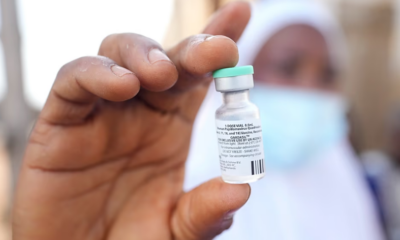Health
EU Sees Record Surge in Harmful Consumer Products in 2024, Chemicals at Core of Concerns
A record number of potentially dangerous consumer products were flagged across the European Union in 2024, with toxic chemicals emerging as a significant concern, according to a new report by the European Commission.
The findings, released through the EU’s Safety Gate Rapid Alert System, recorded over 4,100 alerts last year — the highest number reported in two decades. The system, which tracks threats in consumer and professional goods, excludes food and pharmaceuticals but covers a wide range of products, from cosmetics and clothing to toys and electronics.
The report identified several hazardous substances, including banned fragrances, heavy metals, and so-called “forever chemicals” that remain in the environment and the human body for extended periods. These substances pose serious health risks ranging from skin irritation and reproductive damage to long-term cognitive effects in children.
Banned Fragrance in Cosmetics
One of the most commonly detected substances was a synthetic fragrance known as 2-(4-tert-butylbenzyl) propionaldehyde (BMHCA), also listed as butylphenyl methylpropional. This chemical, which emits a floral scent similar to lily of the valley, was found in nearly all cosmetics reported for chemical risk.
BMHCA has been banned in EU cosmetics since March 2022 due to evidence linking it to skin irritation, fertility issues, and potential harm to unborn children. Despite the ban, it continues to appear in perfumes, deodorants, lotions, and hair products, raising concerns about enforcement and product safety.
Dangerous ‘Forever Chemicals’
The report also highlighted the presence of short-chain chlorinated paraffins (SCCPs) in items like cables and rubber-based products. SCCPs fall under the category of PFAS—per- and polyfluoroalkyl substances—often dubbed “forever chemicals” due to their extreme resistance to environmental breakdown.
Although the import and use of SCCPs are heavily regulated in the EU, these substances were still detected in several products. Research indicates that SCCPs can damage the liver and kidneys, disrupt hormones, and affect child development. The report also warned of their toxicity to aquatic life and potential to accumulate in the food chain.
Lead Exposure Remains a Risk
Another alarming discovery was the toxic metal lead in solders used for bonding metal parts. Even minimal exposure to lead is considered unsafe, with the World Health Organization noting that it can damage the brain, kidneys, and cardiovascular system. Lead is particularly harmful to children and pregnant women, with links to developmental delays, reduced IQ, and behavioral disorders such as ADHD.
An estimated 2.5 million children and adolescents in Western Europe have blood lead levels at or above five micrograms per decilitre — a threshold associated with multiple health issues.
Growing Health and Environmental Concerns
The European Commission’s report underscores the need for stricter enforcement of safety regulations and increased consumer awareness. It also calls on manufacturers and importers to prioritize non-toxic materials and improve product traceability to ensure compliance with EU safety standards.
As concerns about chemical exposure and environmental toxicity grow, the report highlights the urgent need for coordinated efforts to protect public health and the environment from harmful consumer products.
Health
Global Study Finds Sleep May Play Greater Role Than Exercise in Overall Health

A major international study has found that only a small share of people manage to meet recommended levels of both sleep and daily physical activity, raising new questions about long-standing health guidelines and how people can realistically follow them.
The research, published in the journal Communications Medicine, analysed data from wearable sleep and activity trackers from more than 70,000 people across multiple regions over a period of three and a half years. The findings show that only about 13 per cent consistently achieved the commonly promoted targets of seven to nine hours of sleep each night and at least 8,000 steps per day.
Lead author Josh Fitton, a sleep researcher at Flinders University in Australia, said the results highlight the gap between public health recommendations and everyday routines. “Only a tiny fraction of people can achieve both recommended sleep and activity levels every day, so we really need to think about how these guidelines work together and what we can do to support people to meet them in ways that fit real life,” he said.
The study revealed that people often manage to either get sufficient rest or maintain an active routine, but struggle to sustain both. Nearly 17 per cent of participants averaged fewer than seven hours of sleep and fewer than 5,000 steps daily, placing them in what researchers described as a “sedentary” group. This combination has been linked in past studies to a higher likelihood of chronic illness, weight gain and mental health issues.
Researchers noted that the data has limitations, as tracking devices tend to be more commonly used in higher-income countries, potentially skewing the global representation. Even so, the analysis uncovered a consistent pattern across participants: those who slept between six and seven hours a night recorded the highest number of steps the next day.
Senior author Danny Eckert, also from Flinders University, said the findings suggest that sleep may play a stronger role than many realise in shaping daily energy and activity levels. “Prioritising sleep could be the most effective way to boost your energy, motivation, and capacity for movement,” he said.
He added that small adjustments can help people build healthier routines. This includes reducing screen exposure before bed, maintaining regular sleep schedules and creating calming nighttime environments to support better rest.
The study’s authors say the results point to a need for clearer and more practical guidance, especially for people who struggle to balance work, family responsibilities and personal health goals. They say that for many, improving sleep habits may be the most realistic first step toward leading more active and healthier lives.
Health
European Workplaces Face Growing Mental Health Crisis Despite Record Corporate Spending

European companies are pouring unprecedented sums into employee well-being, yet mental health indicators across the workforce continue to deteriorate, raising concerns among researchers, unions and public health agencies.
A continent-wide survey released this year by the European Agency for Safety and Health at Work found that nearly half of workers across 30 countries report overwhelming workloads, while a third feel undervalued in their roles. Another 16 percent say they have faced violence or verbal harassment at work, underscoring the strain many employees experience on a daily basis.
The rise in workplace stress comes even as businesses expand support programmes at a rapid pace. In 2023, companies across Europe spent an estimated $19.6 billion (€16.9 billion) on wellness offerings, which now reach nearly a third of European employees. These initiatives include mindfulness sessions, coaching and stress management training. But researchers say such efforts often miss the root causes of worker distress.
A study by Australian researchers earlier this year labelled the situation a “prevailing paradox,” noting that increasing investment has not translated into improved mental health outcomes. Experts argue that many programmes remain surface-level and fail to target the structural pressures embedded in modern employment.
“After the pandemic, we saw a surge in people experiencing mental health issues linked to work, particularly burnout,” said Sonia Nawrocka of the European Trade Union Institute. She noted that psychosocial risks — such as excessive working hours, job insecurity, limited recognition and workplace bullying — continue to rise despite the attention on wellness.
Manal Azzi, a senior occupational safety and health specialist at the International Labour Organization, stressed that meaningful progress requires companies to rethink how they operate. Recruitment, promotion, performance assessments, management styles and communication practices all influence employee well-being, she said.
Research from TELUS Health suggests that managers who successfully support their teams share several traits, including genuine concern for staff, inclusive leadership, clear decision-making and a focus on purpose rather than just tasks.
Some employers are beginning to adopt wider reforms. Trials of the four-day work week in countries such as the United Kingdom, Ireland, Iceland and Germany have shown early promise in reducing burnout and improving workers’ overall health.
Even so, Azzi said many companies remain hesitant to address deeper organisational issues, often due to perceived cost or uncertainty about how to begin. This is where policy may play a greater role, according to Nawrocka. Sweden has rules to tackle workplace intimidation and unhealthy workloads, while France, Belgium and Portugal enforce right-to-disconnect laws outside working hours.
The economic impact is significant. An ETUI study found that stress-related depression and heart conditions cost the European Union more than €100 billion annually, with employers carrying most of the financial burden.
“When anxiety or depression becomes severe, it can be too late,” Azzi warned. “People leave their jobs, and that’s why prevention is essential.”
Health
New Study Warns Tattoo Ink May Influence Immune Response and Disease Resistance

A major scientific study has raised fresh concerns about the impact of tattoo inks on the body’s immune system, suggesting that the pigments used to create tattoo designs may interfere with how the body responds to disease and vaccination.
Researchers at the Institute for Research in Biomedicine at the Università della Svizzera italiana (USI) examined the toxicity of pigments used in the three most common tattoo colours: black, red and green. The study, published in the journal PNAS, is being described by the team as the most extensive investigation yet into how tattoo inks interact with immune cells.
The scientists found that pigment does not remain confined to the skin. Instead, particles travel through the body and collect in immune tissues, where they can persist for years. Once inside these tissues, the ink triggers cell damage. Macrophages — immune cells responsible for clearing foreign substances — are unable to break down the pigment, leading to swelling and prolonged strain on the immune system.
Pigments used in red and black tattoos caused the strongest reactions in laboratory tests.
When the researchers examined tattooed mice, they recorded rapid movement of pigment to the lymph nodes, where it continued to accumulate for at least two months. The altered immune activity appeared to affect how the animals responded to vaccines. In tests, the mice showed a weaker response to COVID-19 vaccines after tattooing, although the same pigments appeared to strengthen the response to a UV-inactivated flu vaccine.
Scientists stressed that more work is needed to confirm these findings in humans and across a wider range of vaccines. The International Agency for Research on Cancer (IARC) is conducting separate research into possible long-term risks, including links between tattoo pigments, the immune system, and cancers such as lymphomas.
Researchers note that many pigment particles are extremely small, allowing them to circulate beyond the dermis, the layer of skin where tattoos are placed. This raises the possibility that exposure is not limited to the area of the tattoo.
Tattooing has become increasingly common, especially in Europe and the United States, where up to 40 percent of adults under 40 have at least one tattoo. IARC has said that the growth of the tattoo industry has turned pigment safety into a rising public health concern.
Tattoo ink can contain up to 100 chemical substances. Black ink usually contains carbon-based pigments, while coloured designs often rely on industrial pigments originally meant for plastics or paints. Europe introduced new rules in 2022 under its REACH chemical safety regulation to bring stricter oversight to ingredients used in tattoo inks.
With tattoo popularity rising worldwide, scientists say understanding these biological effects is becoming increasingly important.
-

 Entertainment1 year ago
Entertainment1 year agoMeta Acquires Tilda Swinton VR Doc ‘Impulse: Playing With Reality’
-

 Business2 years ago
Business2 years agoSaudi Arabia’s Model for Sustainable Aviation Practices
-

 Business2 years ago
Business2 years agoRecent Developments in Small Business Taxes
-

 Home Improvement1 year ago
Home Improvement1 year agoEffective Drain Cleaning: A Key to a Healthy Plumbing System
-

 Politics2 years ago
Politics2 years agoWho was Ebrahim Raisi and his status in Iranian Politics?
-

 Business1 year ago
Business1 year agoCarrectly: Revolutionizing Car Care in Chicago
-

 Sports1 year ago
Sports1 year agoKeely Hodgkinson Wins Britain’s First Athletics Gold at Paris Olympics in 800m
-

 Business1 year ago
Business1 year agoSaudi Arabia: Foreign Direct Investment Rises by 5.6% in Q1



























